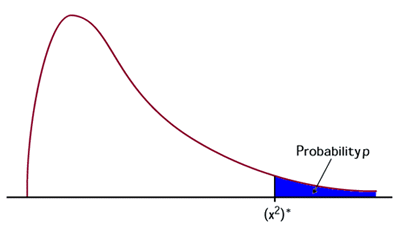

Each individual tastes each of the three colas. Between tastes subjects eat a soda cracker. Each subject receives the colas in a different order. Each subject then selects which soda he/she likes best.
Results: Pepsi 85, Coke 57, RC 78.
| O | E | O-E | (O-E)2 | (O-E)2/E | |
|---|---|---|---|---|---|
| Pepsi | 85 | 73.33 | 11.67 | 136.19 | 1.86 |
| Coke | 57 | 73.33 | -16.33 | 266.67 | 3.64 |
| RC | 78 | 73.33 | 4.67 | 21.81 | 0.3 |
| Totals | 220 | 219.99 | χ2 = | 5.8 |
df = rows - 1 = 3 - 1 = 2.
Critical value of χ2 = 5.99 at alpha = 0.05.
Observed value of χ2 = 5.8.
Decision: Fail to reject H0.
clear
input o
85
57
78
end
generate e = 220/3
chitest o e
observed frequencies from o; expected frequencies from e
Pearson chi2(2) = 5.7909 Pr = 0.055
likelihood-ratio chi2(2) = 5.9984 Pr = 0.050
+-------------------------------------------+
| observed expected obs - exp Pearson |
|-------------------------------------------|
| 85 73.333 11.667 1.362 |
| 57 73.333 -16.333 -1.907 |
| 78 73.333 4.667 0.545 |
+-------------------------------------------+
She wants to test the absences at the 0.1 significance level.
| O | E | O-E | (O-E)2 | (O-E)2/E | |
|---|---|---|---|---|---|
| Mon | 73 | 61 | 12 | 144 | 2.4 |
| Tue | 57 | 61 | -4 | 16 | 0.3 |
| Wed | 48 | 61 | -13 | 169 | 2.8 |
| Thu | 59 | 61 | -2 | 4 | 0.1 |
| Fri | 68 | 61 | 7 | 49 | 0.8 |
| Totals | 305 | 305 | χ2 = | 6.4 |
df = rows - 1 = 5 - 1 = 4.
Critical value of χ2 = 7.78 at alpha = 0.10.
Observed value of χ2 = 6.4.
Decision: Fail to reject H0.
clear
input o
73
57
48
59
68
end
sum o
Variable | Obs Mean Std. Dev. Min Max
-------------+-----------------------------------------------------
o | 5 61 9.77241 48 73
generate e = r(sum)/5
chitest o e
observed frequencies from o; expected frequencies from e
Pearson chi2(4) = 6.2623 Pr = 0.180
likelihood-ratio chi2(4) = 6.3196 Pr = 0.177
+-------------------------------------------+
| observed expected obs - exp Pearson |
|-------------------------------------------|
| 73 61.000 12.000 1.536 |
| 57 61.000 -4.000 -0.512 |
| 48 61.000 -13.000 -1.664 |
| 59 61.000 -2.000 -0.256 |
| 68 61.000 7.000 0.896 |
+-------------------------------------------+
chitable 4
Critical Values of Chi-square
df .50 .25 .10 .05 .025 .01 .001
4 3.36 5.39 7.78 9.49 11.14 13.28 18.47
An SRS of 1220 individuals in 1995 found 585 Anglo, 390 Hispanic, 109 African-American and 136 Asian.
Have the demographics in the county changed greater then would be expected by chance
| O | E | O-E | (O-E)2 | (O-E)2/E | |
|---|---|---|---|---|---|
| An | 585 | 634.4 | 49.4 | 2,440.36 | 3.85 |
| H | 390 | 341.6 | 48.4 | 2,342.56 | 6.86 |
| AA | 109 | 146.4 | -37.4 | 1,398.76 | 9.55 |
| As | 136 | 97.6 | 38.4 | 1,474.56 | 15.12 |
| Totals | 1220 | 1220 | χ2 = | 35.38 |
df = rows - 1 = 4 - 1 = 3.
Critical value of χ2 = 7.81 at alpha = 0.05.
Observed value of χ2 = 35.38.
Decision: Reject H0.
clear
input o
585
390
109
136
end
input e
634.4
341.6
146.4
97.6
end
list
+-------------+
| o e |
|-------------|
1. | 585 634.4 |
2. | 390 341.6 |
3. | 109 146.4 |
4. | 136 97.6 |
+-------------+
chitest o e
observed frequencies from o; expected frequencies from e
Pearson chi2(3) = 35.3669 Pr = 0.000
likelihood-ratio chi2(3) = 34.4401 Pr = 0.000
+-------------------------------------------+
| observed expected obs - exp Pearson |
|-------------------------------------------|
| 585 634.400 -49.400 -1.961 |
| 390 341.600 48.400 2.619 |
| 109 146.400 -37.400 -3.091 |
| 136 97.600 38.400 3.887 |
+-------------------------------------------+
Now let's use the hsb2 dataset and the variable race.
use http://www.philender.com/courses/data/hsb2, clear
chitest race, count /* down loaded from the Internet */
Chi-square test:
observed frequencies from race
expected frequencies equal
Pearson chi2(3) = 242.4400 Pr = 0.000
likelihood-ratio chi2(3) = 203.5732 Pr = 0.000
residuals
observed expected classic Pearson
1. 24 50.000 -26.000 -3.677
2. 11 50.000 -39.000 -5.515
3. 20 50.000 -30.000 -4.243
4. 145 50.000 95.000 13.435
Intro Home Page
Phil Ender, 28nov05, 22Nov00